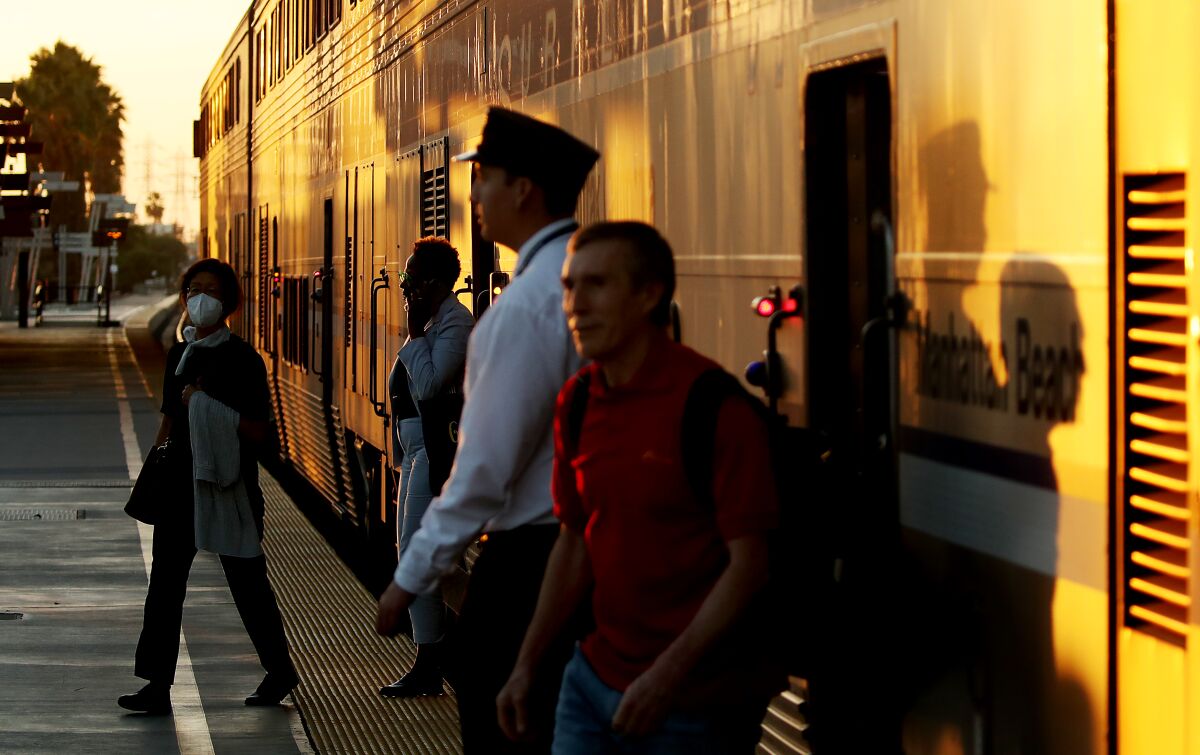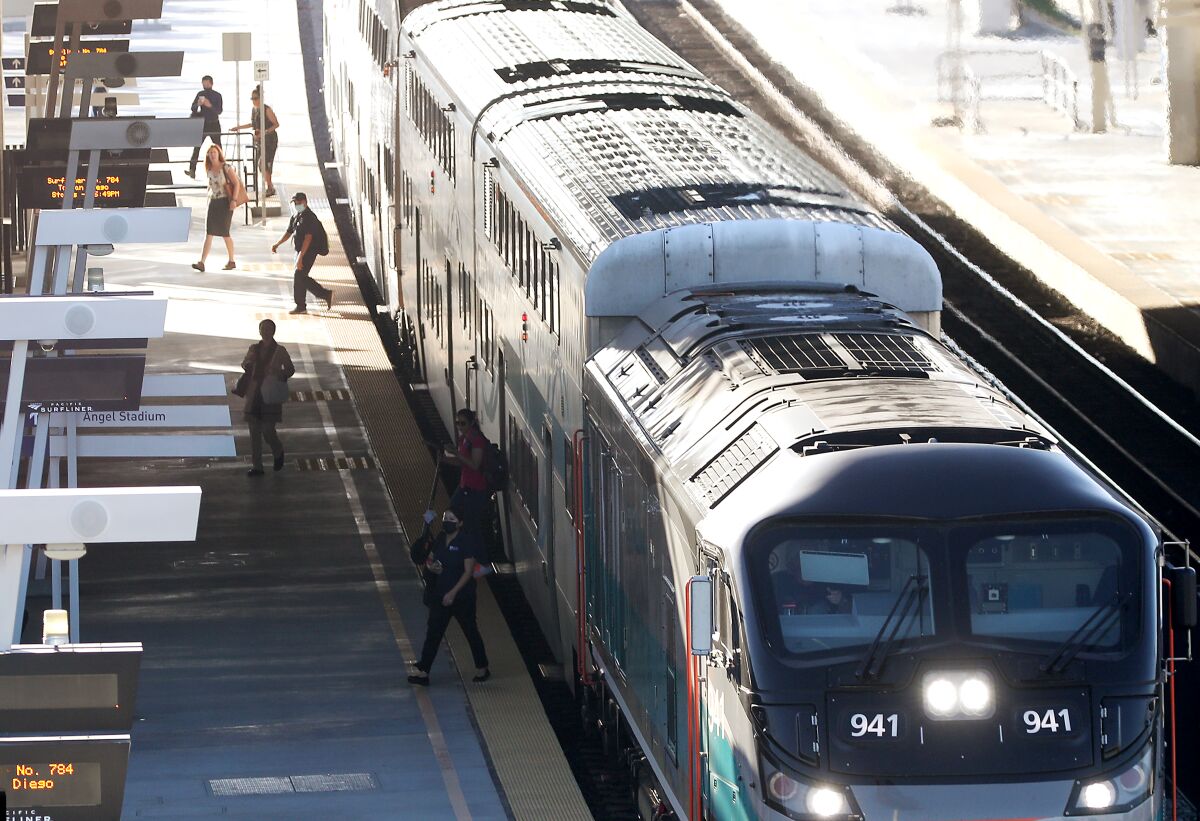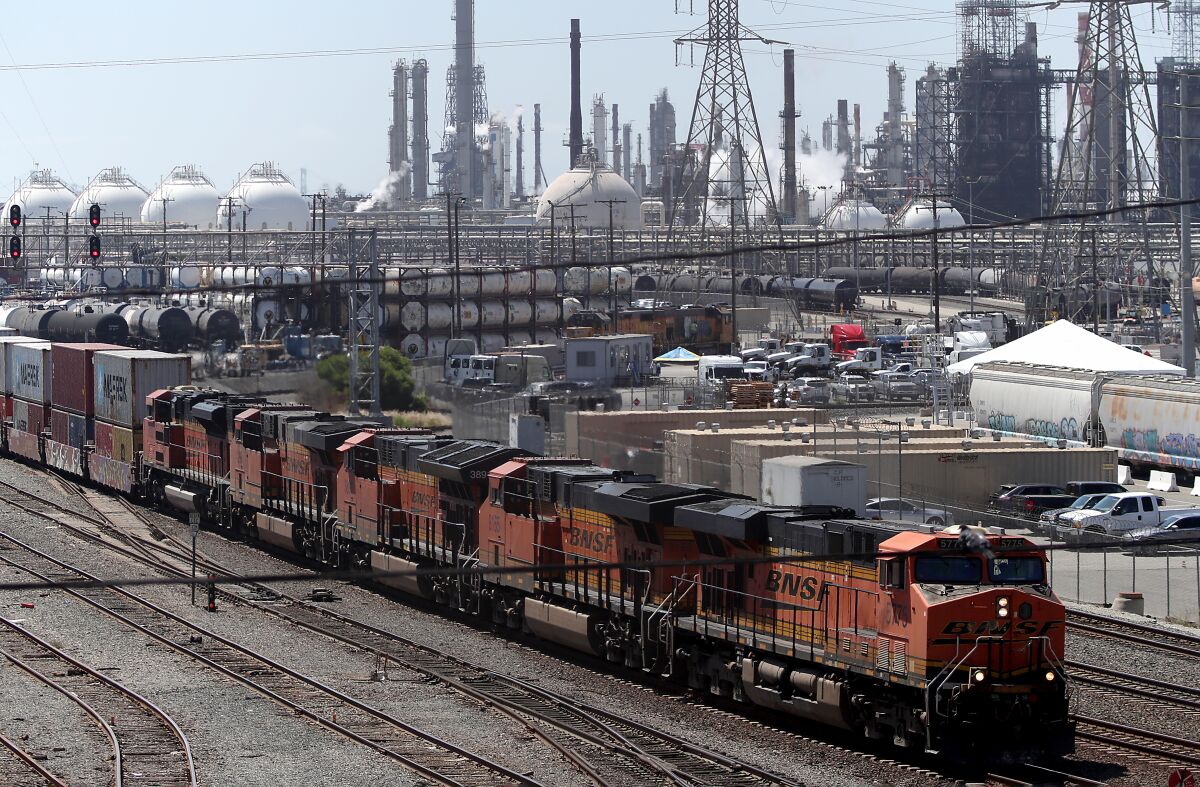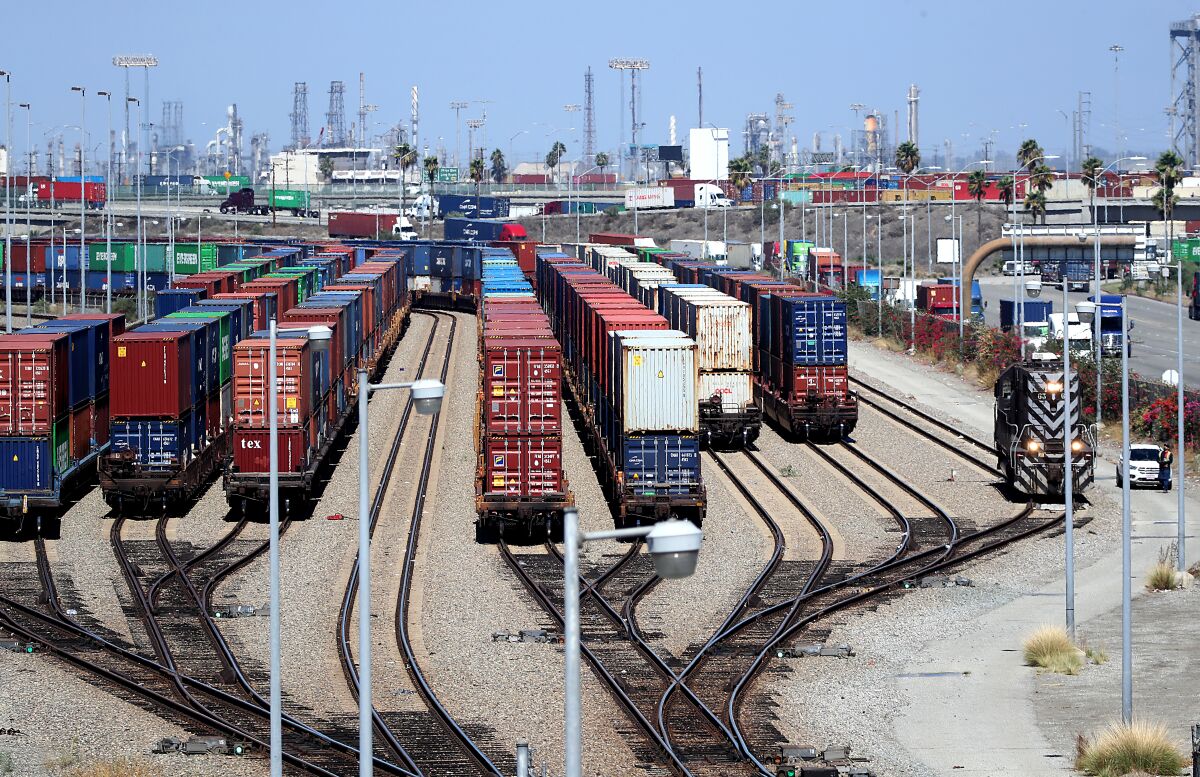The nation’s freight railroads, a crucial lifeline of the U.S. economy, teetered on the brink of a massive strike Wednesday over staff cuts that have led to what unions call brutal working conditions for the remaining rail conductors and engineers.
Bargaining between the railroads and 12 unions, ongoing since 2019, came to a head in recent months. President Biden convened an emergency panel that recommended pay increases but failed to address union concerns over burnout, scheduling and sick pay.
Federal law requires a 30-day “cooling off” period that expires Friday just after midnight Eastern time. Biden has been calling both sides, and Labor Secretary Marty Walsh hosted talks Wednesday in an effort to avoid a strike or a lockout.

Passengers disembark from the Amtrak Pacific Surfliner in Anaheim on Wednesday.
(Luis Sinco / Los Angeles Times)
If they fail, as many as 125,000 rail workers led by the Brotherhood of Locomotive Engineers and Trainmen, and the transportation division of the International Assn. of Sheet Metal, Air, Rail and Transportation Workers, could walk off the job Friday.
Under the Railway Labor Act, Congress can intervene, block a strike and force the unions to accept the recommendations of the emergency panel. Senate Democrats on Wednesday blocked a Republican effort to impose the contract deal proposed by Biden’s advisory board.
What’s at stake for the economy?
A railroad strike could devastate businesses that rely on Union Pacific, BNSF, Norfolk Southern, CSX and other major freight railroads to deliver raw materials and ship their products — another possible burden for industries that have struggled through years of pandemic-induced supply chain snarls.
“You cannot understate the importance of the railroads to this economy,” said John Drake, an executive at the U.S. Chamber of Commerce. “They move 40% of the freight-ton-miles in this country. One-third of all exports move by rail. If it’s grain, if it’s chemicals, if it’s cold, it’s moving by rail.”
The Assn. of American Railroads trade group estimates that a strike would cost the economy $2 billion a day.
About 300,000 barrels of crude oil is shipped by rail every day, and refineries might have to slow production if deliveries are delayed, according to the American Fuel & Petrochemical Manufacturers. Analysts warn there could be shortages of gasoline and diesel in some places.

A Metrolink train arrives in Anaheim.
(Luis Sinco / Los Angeles Times)
New vehicles are usually shipped from the factory or dock by rail. A strike would mean longer wait times for dealers and car buyers who have already been stymied by pandemic-related delays.
Most worrisome is how a strike could fuel inflation. Food, one of the main drivers of higher prices, is particularly vulnerable. The railroads announced plans to stop shipping refrigerated items ahead of the strike deadline, potentially affecting deliveries of produce and meat. Farmers could suffer as shipments of feed to livestock and poultry are interrupted.
“This could bump up inflation even further to 10%,” said Robert Handfield, professor of supply chain management at North Carolina State University.
With a rail strike idling 7,000 long-distance trains a day, the trucking industry, which is also facing worker shortages, would be unable to fill the gap. “Other sectors can’t absorb the capacity. They are already too strained,” he said.
And consumers could be the ones who pay the price, said Tom Madrecki, vice president of supply chain and logistics for the trade group Consumer Brands Assn. Household brands such as Coca-Cola, General Mills and Bayer are part of the association. Many of his members are especially worried about access to raw materials, including wheat, peanuts and the plastic pellets used in making bottles.

Passengers get off a Metrolink train in Anaheim.
(Luis Sinco / Los Angeles Times)
Producers of packaged foods sold in grocery stores or pharmacies could hold out for a week or so, but without raw materials being delivered they are likely to start facing shortages themselves, he said.
“There’s a very real impact that you might expect out of this,” he said. “It shouldn’t be consumers can’t get food period, but very quickly, there’s only so much safety stock.”
Water agencies have also raised red flags. With shipments of chlorine for cleaning water sitting on the tracks, several say a strike could threaten public health.
“Unless freight rail service for chlorine returns to normal soon, communities will be unable to produce safe drinking water, resulting in many boil-water advisories and the threat of waterborne disease outbreaks,” said a joint letter sent to Congress by some of the nation’s leading water associations.
How would California be affected?
A strike could have wide-reaching consequences for the Golden State.
California’s multibillion-dollar agricultural industry could suffer. Railroads typically transport roughly 60,000 carloads of food and agricultural products a week.
Freight operators have already started to limit the shipments of hazardous materials, including materials used for fertilizers by the state’s agricultural industry.
The nation’s largest water wholesaler, the Metropolitan Water District of Southern California, said its customers are concerned a strike could leave them without supplies. The district provides water in six counties, including Los Angeles, for more than 19 million people. Many water providers that purchase from the district buy disinfecting chemicals that are largely delivered via train on an as-needed basis and don’t have a reserve inventory.

A freight train rolls past an oil refinery in the Port of Los Angeles.
(Luis Sinco/Los Angeles Times)
The district has said that it keeps a one-month supply on hand, but shipments have stopped after the rail companies halted deliveries of hazardous waste.
“We’re concerned. We had expectations of deliveries this week that the rail companies are no longer delivering,” said Heather Collins, Metropolitan’s manager of water treatment. “We were counting on inventory coming in to prepare us for this potential strike.”
A two-week supply of chlorine alkali chemicals is now sitting on the tracks somewhere in Southern California, and the district can’t get it.
“Every seven days will be a more critical, increasing concerning point,” she said.
And commuters could be stranded.
Both Metrolink and Amtrak, which operate the majority of their service on freight-owned tracks, are prepared to significantly cut services.
Five of the seven lines that Metrolink runs will see cancellations of service beginning at 8 p.m. Thursday, if a strike occurs.

Containers stacked on rail cars in the Port of Los Angeles.
(Luis Sinco/Los Angeles Times)
“This level of service interruption is significant. Not only does it negatively affect our riders but how people can navigate Southern California,” said Scott Johnson, a spokesman for Metrolink.
The Antelope Valley and San Bernardino lines will continue uninterrupted, while the Ventura County line will operate only between Los Angeles and Moorpark.
Lines that connect Los Angeles to Riverside, the Perris Valley and Oceanside, along with another line that connects the Inland Empire and Orange County, will be suspended. Metrolink has coordinated with Amtrak Pacific Surfliner train service to allow ticketed passengers to ride between Oceanside and Fullerton with a bus connection to Los Angeles.
Amtrak canceled all long-distance rail service nationwide beginning Thursday that includes trains that run to Chicago from Los Angeles and San Francisco and along the West Coast from Seattle to Los Angeles. The company said phased adjustments will be made to its schedules.
“These adjustments are necessary to ensure trains can reach their terminals before freight railroad service interruption if a resolution in negotiations is not reached,” the company said in a statement.
Most trains along the Northeast Corridor will not be affected. And in the San Francisco Bay Area, BART will continue to run.
Along the docks of the Los Angeles and Long Beach ports, still reeling from the pandemic-induced supply chain crunch, officials are bracing for more backups.
Two-thirds of all cargo leaves California by rail. Already, cargo boxes headed for rail cars are piling up, with a backup three times normal.
“Rail operations are critical to fluidity of the supply chain,” said Michelle Grubbs, an executive at the Pacific Merchant Shipping Assn., which represents the shipping companies that ferry goods to West Coast ports.
How did it come to this?
No railroad strike has occurred in the last three decades.
But in sweeping cost-cutting measures, the largest freight railroads have slashed their workforces by 29% in the last six years, according to data supplied to the U.S. Surface Transportation Board. They have shut down less-profitable routes, consolidated railyards and run fewer, longer trains, thus snarling roadway crossings.
Rail workers have gone without a raise since 2019 as the companies’ profits have boomed and stock buybacks have boosted shareholder values. BNSF, owned by Warren Buffett’s Berkshire Hathaway, reported record net earnings of $5.99 billion in 2021, up 16.1% from 2020. Union Pacific had its most profitable year ever in 2021, with net income of $6.5 billion, up from $5.6 billion in 2020.
Rail employees remained on the job throughout the pandemic, often working mandatory overtime to compensate for staff cuts and defections. Workers complain they are unable to get sufficient rest between shifts because of stricter on-call policies.
Nonetheless, rail workers are penalized under a points system if they miss work to go to the doctor without scheduling a medical visit in advance. Too many points results in termination.
“Our members are being terminated for getting sick or for attending routine medical visits as we crawl our way out of a worldwide pandemic,” Jeremy Ferguson, president of the SMART Transportation Division, and Dennis Pierce, president of the Brotherhood of Locomotive Engineers and Trainmen, said in a joint statement.
“These employment policies have forced thousands of employees out of the industry and make it all but impossible to recruit new workers.”
Railroads say stricter attendance standards and “precision” scheduling are needed to compensate for staff shortages.
Railroads are also pushing to cut mandated two-person crews in each train to one person, a strategy that unions say would result in more crashes and injuries, with exhausted workers vulnerable to falling asleep.
The impasse comes at a time when workers across the economy are rebelling against mandatory overtime, unpredictable scheduling, production quotas, workplace surveillance and other onerous practices that boost corporate profits but take a toll on workers’ health and family life. Interest in forming unions is rising as a result.
What did Biden’s panel recommend?
To ward off a strike, Biden’s emergency board recommended pay raises of 24%, including an immediate raise of 14%, and bonuses of $5,000 over five years. The 124-page report also said workers should pay more for health insurance.
Union officials had asked for a 31% pay raise over five years. Railroads had offered 17%. Unions say the pay boost would not keep up with inflation, which reached 8.3% last month. But they say they are willing to accept a wage compromise.
Although several smaller unions, including maintenance workers, accepted the panel’s recommendations, the two largest unions, representing 57,000 conductors and engineers, say they will strike unless railroads adopt changes to what they call draconian scheduling and sick leave practices. Nearly 5,000 workers represented by the International Assn. of Machinists and Aerospace Workers also rejected the panel’s recommended contract. Members of the smaller unions would refuse to cross picket lines, their leaders said.
What do the unions want?
Unions gave up their initial request for paid sick leave, but they are adamant that workers need to have access to unpaid leave to go to the doctor, without being penalized for last-minute requests.
Workers can be on call for 14 days straight and even when they return home from a trip, they can be roused in the middle of the night to work another shift.
Over 17 years, Michael Paul Lindsey, a Union Pacific engineer, worked out of Roseville, San Luis Obispo, Fresno, Oakland and, finally, Pocatello, Idaho — wherever the railroad needed him most.
In 2018 and 2019, the company’s “precision scheduled railroading” practices meant “cutting conductors and engineers, maintenance, signal department, track, mechanical management,” he said. “And they expect everyone left to carry the burden and work longer hours to make up for what those employees used to do.”
He spends about 200 days a year away from home and, at age 35, he says, “I’m exhausted. We’re on call 24 hours a day, seven days a week, whether it’s Christmas or not. They wake you over and over in the middle of the night because they are out of people.
“There’s weeks that you’re out of town for 48 hours and you’re home for 10 hours and then you have to go out for another 48 hours again, and you do that over and over again.”
Lindsey made $83,000 before taxes last year. “Of course, you’re gonna make a lot of money,” he said, “but you’re never home.”
The absences have taken a toll on his 11-year-old daughter, Emma, he said. “She has fallen behind in school, and I can’t be there to help her very often. It makes me feel horrible.”
When he is out of town, Union Pacific gives him $12 to cover his meals for two days. He is put up in a cheap hotel, but the first 16 hours of a layover are unpaid.
“The railroads have lost the loyalty of an entire generation of skilled, experienced workers,” he said. “We can and will walk away.”
BNSF Railway made some adjustments to its new attendance policy in May, but workers can still be terminated if they miss work on “high impact” days when there is heavy demand.
One change could be dangerous, unions say. “BNSF’s proposal to reward the ‘top performers,’ or those who have the top 10% of work hours, is a clear attempt to incentivize these fatigued workers to double down,” said Greg Regan, president of the AFL-CIO’s Transportation Trades Department.
What do rail officials say?
Asked for comment, a Union Pacific spokeswoman said in an email, “Considering the looming possibility of a national rail labor strike, we are prepared to take the proactive steps to secure our customers’ goods…. What we want, and continue to push for, is a prompt resolution that provides historic wage increases to employees and allows the railroads to restore service as soon as possible, preventing further disruption to the struggling supply chain.”
A BNSF spokeswoman denied that workers are unable to take time off for illness or medical appointments.
“More than 50% of train crew employees work less than 40 hours a week on average,” she wrote in an email. “Generally, train crew employees have over three to four weeks of paid vacation and more than 10 personal leave days.
“Depending on craft and seniority, these numbers can extend to five weeks of vacation in addition to 14 paid holidays and/or paid leave days.”
Sick leave and attendance issues can be addressed through binding arbitration and are also being addressed through higher wages, she wrote. However, the railroad is open to “further local negotiations regarding issues relating to schedule predictability and time off,” she said.
What are the political stakes?
The threatened strike comes at a politically perilous time for Biden.
With the congressional midterm elections less than two months away, Biden wants voters focused on Democrats’ legislative wins while painting the Republican Party as extreme in the aftermath of the Jan. 6 insurrection and the Supreme Court’s ruling ending federal protections for abortion.
Another economic earthquake, added to inflation, which has surged because of pandemic-related spending and rising energy prices caused by Russia’s invasion of Ukraine, is the last thing Biden and Democrats are looking for.
“It happens at a delicate moment in the economy and in politics,” said Joseph McCartin, a Georgetown professor and executive director of the Kalmanovitz Initiative for Labor and the Working Poor.
But resolving the conflict and avoiding a politically devastating strike could force the president to go up against one of his dearest political constituencies: labor unions.
Times staff writer Eli Stokols, the Associated Press and Bloomberg contributed to this report.
Stay connected with us on social media platform for instant update click here to join our Twitter, & Facebook
We are now on Telegram. Click here to join our channel (@TechiUpdate) and stay updated with the latest Technology headlines.
For all the latest Business News Click Here
